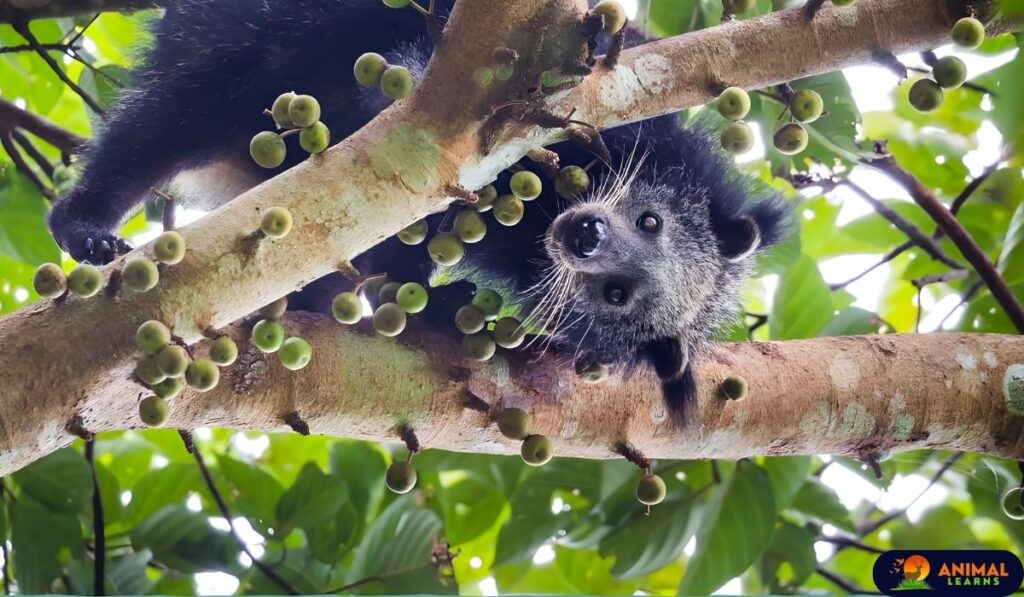Binturong | Lifespan, Diet, Habitat, Facts (With Pictures)

The bearcat, commonly referred to as the binturong, is a member of the ancient family Viverridae. Small to medium-sized mammals that are unique to Afro-Eurasia. They are found in Southeast Asia’s thick tropical jungles.
Due to scent glands located directly behind the tail, binturong have a buttered popcorn-like smell.
Due to an estimated 30% or greater decline in population during the past three decades, the binturong has been classified as a vulnerable species on the IUCN Red List of Threatened Species. Hunting, the illegal wildlife trade, and habitat deterioration are the top dangers facing binturongs.
The Appearance of Bearcat
Contents
Imagine a furry animal that looks like a mix of a bear and a cat. This is a remarkable creature with a distinctive appearance. They have a bear-like body shape and a long, bushy tail that can wrap around branches.
Their fur is dark brown or black, with some white or grayish hairs that make them look speckled. But the most striking feature of this animal is their face.
They have small, rounded ears, a short snout, and expressive eyes that can charm anyone. They also have sharp, curved claws and large paws that help them grip branches in their tree-top home.
Diet
Despite belonging to the carnivorous order, binturongs consume a lot of fruit. They will, however, also consume carrion, eggs, plant buds, and leaves since they are opportunistic. Since they are skilled hunters, they will sometimes eat fish, birds, small animals, and invertebrates.
Habitat
Primarily arboreal, binturongs inhabit the canopy of towering, dense tropical forests. They live in large evergreen forests in Lao and in primary and secondary lowland forests with grasslands in the Philippines. They sleep in the branches of trees and spend much of their time climbing.
Binturong Lifespan
In the wild, binturongs can live up to 18 years, while in captivity, they can live up to 25 years.
| Lifespan Category | Status | Lifespan (years) |
| Range Lifespan | Wild | 18 (high) years |
| Average Lifespan | Wild | 18.0 years |
| Range Lifespan | Captivity | 25 (high) years |
| Average Lifespan | Captivity | 22.7 years |
Behavior

Although they are not absolutely territorial, binturongs spend most of their time alone and avoid conflict. They are too big to jump from tree to tree, so they spend most of their time on the ground, but they also spend a lot of time climbing. It has also been observed that binturongs swim and dive for food. As they cautiously and gently ascend, their prehensile tail serves as an additional limb.
When they climb trunks, they can increase the grasping power of their back claws by rotating their hind legs backwards. When they walk, their feet are flat and they amble. Although they have also been characterized as crepuscular and even diurnal, binturongs are primarily believed to be nocturnal.
Binturong Lifestyle
- Treetop Dwellers: They are the ultimate treehouse architects. They build their homes in the treetops, where they have the best views and no noisy neighbors (except maybe some chatty birds).
- Forest Explorers: They’re like forest explorers with fur coats. They roam the lush forests of Southeast Asia, swinging from tree to tree and discovering all the best hide-and-seek spots.
- Seed Spreaders: They are the Johnny Appleseeds of the forest. They munch on fruits, digest the seeds, and then plant new trees wherever they, well, you know, “go.” Talk about a green thumb, or should we say a brown paw?
- Nap Enthusiasts: These guys take their beauty sleep seriously. When they’re not foraging for food or planting future forests, they’re catching some Z’s in their cozy tree hammocks.
- Nature’s Perfume Makers: With their popcorn-scented musk, They are like nature’s own perfume makers. Forget fancy fragrances; just hang out with a binturong if you want to smell delicious.
Interesting Facts about the Binturong

- They are night owls. Binturongs are mostly active at night when they use their keen senses and bright eyes to navigate the dark. They can even see ultraviolet light, which helps them find food and avoid predators.
- They are acrobats of the trees. They are expert climbers, thanks to their long tails and flexible ankles. Their tails can grip branches and act as a balance, while their ankles can rotate 180 degrees, allowing them to descend headfirst or hang upside down.
- They eat almost anything. They have a diverse diet, ranging from fruits and leaves to insects and small mammals. They especially love figs, which make up most of their fruit intake. By eating and dispersing seeds, they help maintain the health of their forest habitat.
- They are loners but not antisocial. Bear cats usually live alone, except during the breeding season, when they become more social and playful. They have a complex courtship ritual, involving vocalizations, grooming, and tail-wrapping.
- They have a unique mating style. Bear cats mate in the trees, using their climbing skills to their advantage. The male hangs from a branch by his tail, while the female wraps her tail around him and holds on with her claws. This way, they can mate without falling off.
Reproduction

The mating habits of binturongs have not been extensively studied. It is most certainly a monogamous system because the father of a mated pair stayed with the mother and young after birth. But the father doesn’t always stick around to assist the female in raising the kids.
Binturong groups typically consist of the mother and her young female offspring. Unless the females are in estrus, when they emit a call that draws males, binturongs are usually solitary. Unless they are in estrus, males frequently behave defensively toward females.
Mating System
Binturongs mate all year round, suggesting that they don’t have a specific reproductive season. Nonetheless, a rise in births has been observed between January and March, which may be the consequence of postponed implantation.
The average litter size during the 91-day gestation period is two, but there may be as many as six. The sexual maturity period for males and females is approximately 28 months for males and 30 months for females.
Predators
Binturongs are probably predated upon by tigers (Panthera tigris) and dholes (Cuon alpinus) in Thailand, despite their fangs and claws. There have been reports of clouded leopards preying on binturongs on the Malaysian Peninsula.
Binturong Like to Climb
The majority of Binturong are arboreal, living at the tops of large trees. With the help of their powerful feet and semi-retractable claws, they are exceptional climbers. They can descend a tree head-first by rotating their hind legs backwards, which allows their claws to maintain a firm grasp. They will cuddle up and sleep high up in tree limbs.
FAQs
Are Bearcats friendly?
Bearcats can be friendly but are typically solitary and cautious around humans.
Are bintu-rong aggressive?
They are not usually aggressive, but they can defend themselves if they feel threatened.
Why do they smell like popcorn?
They have scent glands that produce a musky, popcorn-like odor. This scent helps them communicate with others and establish territory.
Is a binturong a cat?
Despite their name, they are not cats; they belong to a different family called Viverridae.
Is it predator or prey?
They are typically preyed upon by large birds of prey, snakes, and big cats like leopards.
What do they eat?
They are omnivores, primarily feasting on fruits, leaves, and plant matter. They also enjoy insects, small mammals, and eggs, especially in captivity.
Which big cat is friendly to humans?
No big cat is truly friendly to humans in the wild. Some can be habituated to human presence in captivity, but they are still wild animals.
Do bearcats smell like popcorn?
Yes, They are known for their distinctive popcorn-like smell.












